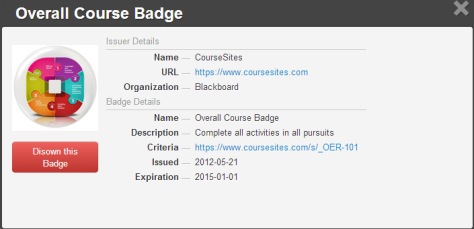So a little more than a week ago, I revealed that I was taking a MOOC on Open Educational Resources. Well, I’ve finished with the course in just nine days!

First thing’s first: I really learned very little that was new to me in this course that I couldn’t have learned from reading a bunch of websites and blogs. However, the great thing was that the information was consolidated in one place. Perhaps the most useful thing was a list of resources that I’ve compiled for things like Open Access Textbooks and repositories of teaching materials. I also learned a few things about using and remixing Creative Commons licenses that I didn’t know before: Share-Alike licenses do not mix well with Non-Commercial licenses, and there’s a way to search for licensed content via the Creative Commons website. Some of the material included in the course was not exactly in the best format — fifty minute long videos of Google hangouts with no outline or accompanying notes or visuals were pretty difficult to handle. Those bored me quite quickly, especially since most of them were just videos of conversations — conversations that I was not part of and could not interact with. That was mildly frustrating, and I hope the developers of the course find a better way to display the information contained in those long videos.
Now, one of my favorite things from the course: the OER Commons. This is not only a repository for educational resources, separated by discipline and level, but also a platform for creation of these resources. This is where I put together a version of an assignment I gave in one of my classes last year to share — I embedded a YouTube video and put in some homework or in-class discussion questions right next to the video. I also had the option of including images and other videos in the same place. Finally, I was able to include metadata — appropriate topic sections, grade level, type of resource, and accessibility concerns. After submitting it, suddenly my homework assignment was deposited and available to be used by other instructors. I kind of wish I were still teaching so I could use some of the things found here!
One of the aspects of the course that interested me the most was the badge system. Each time I completed a section of the course, I took a short survey and received a badge through the Open Badge system. You can see my badge backpack here. I admit, it felt nice to “get” something for completing part of the course besides my own satisfaction. Instead of some kind of “certificate of completion” at the end, I received a full badge made up of all the ones I had received along the way (it’s the one shown in the image above). It’s an innovative way to show progression and achievement, and I hope that it will be adopted more widely.
(Small caveat: I did notice that it would be easy to game the badge system – the criteria was that the final module needed to have a button clicked that said “Mark Reviewed”. As far as I could tell, it did not really check to make sure you had completed all of the sections or done all of the activities. After clicking the button, you could access the survey to get your badge. Of course, I am interested in the content so I went back to complete it, but, I thought I might as well put this out there.)
In all, I found OER-101 to be a lot of information that I already knew, but a nice collection of resources that I had a chance to explore. It was my first encounter with the badge system, and I found it to have a positive impact on my experience. I would recommend this course for instructors who have little to no experience with open access or open educational tools; even for those with experience, it may still be informative even if a bit repetitive.


